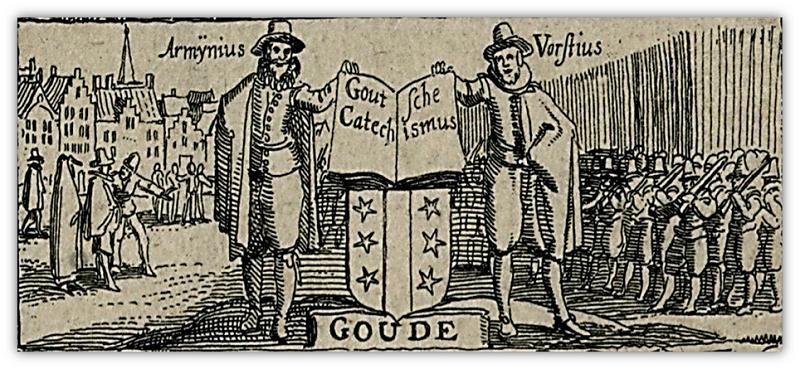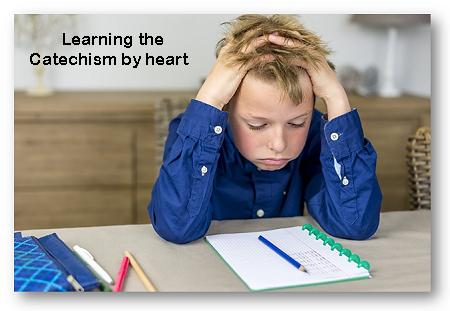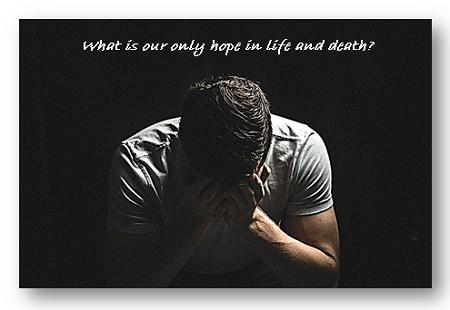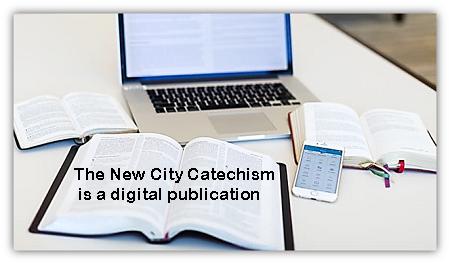A Future for the HC in Tomorrow's Instruction?
A Future for the HC in Tomorrow's Instruction?

It was 406 years ago this year that the Goudse Catechismus appeared in the Dutch city of Gouda. This was an instruction method for children and families, indeed for the whole city of Gouda. It came about because one of its authors, Reverend Herman Herberts, had been fit to preach something other than from the Heidelberg Catechism in his former congregation of Dordrecht. He had chosen his own subject for the sermon and was of the opinion that this was far better.
He had not enamoured himself to his fellow office bearers in the church of Dordrecht by so doing. One dispute followed another, and he was alternately expelled and restored to office. In the more liberal city of Gouda he wrote the Goudse Catechismus, which soon became a part of the dispute between Remonstrants and Contra-Remonstrants. The critical reception of this booklet soon showed that it was being seen as an alternative for the Heidelberg Catechism. In spite of its mild and irenic tone, it was given a political edge: critics claimed that liberal Gouda, in the wake of Erasmus and Coornhert (humanistic theologians who influenced Gouda), was trying to educate the people with a theology that gave no offence, with the ultimate purpose of replacing the Heidelberg Catechism as the Reformed Confession of Faith.
Some observations can be made from this short description of events. For example, how quickly the Heidelberg Catechism had become a confessional document: an authoritative text for catechetical instruction in the congregation and the expression of the Reformed identity of the Dutch church born of the Reformation. What also stands out is how a pedagogic goal – bringing up young people in the faith – could become the main issue in confessional, theological, and even political strife. This battle was being fought over the heads of the youth. Here, at the festivities of the 450-year anniversary of the Heidelberg Catechism, this is an example of one of those historical incidents where the value of the catechism was challenged.
Yet this article is about the Heidelberg Catechism and not about the presentation of a new Goudse Catechismus. I would like to bring forward a thesis at the end of this contribution, but first I would like to share a few personal experiences with you.
These will then be placed within some broader observations and, in conclusion, I will discuss the three characteristics of the catechism in faith education for today and tomorrow.
Personal Experiences⤒🔗
Let me begin with my own period of catechesis, in which a catechist and 30 catechumens were seated around a table. Every week the catechist would write a new sentence on the blackboard and after 8 weeks we had worked our way through Lord’s Day 1 of the Heidelberg Catechism. Although one might have some reservations about this from a didactic point of view, I remember it with gratitude. I learned Lord’s Day 1 by heart there, an inheritance that has lasted a lifetime.
The following experience testifies to that. An elderly sister from my church had suffered a stroke and was no longer able to speak. All she could say was ‘yes’. Her daughter sung the psalms to her and these had become so internalized that her mother could get in touch with them. But once all the psalms had been sung, they discovered something else in their mother. Reciting Lord’s Day 1 of the Heidelberg Catechism awakened a deep memory within her. She could not speak, except for those old words of faith.

Yet there is another side to be mentioned. In the same period I was giving a catechism course to prepare the older youth for their public professions of faith. The catechism textbook that I was using had fragments of the Heidelberg Catechism incorporated into the lessons. One day I handed out books containing the Confessions of Faith to the group, to give them a chance to read the whole Catechism, rather than just the fragments in the Catechism textbook. While paging through it, one of the participants, a motivated and very much involved student, in his twenties, remarked: “Hey, I used to have to learn this by heart. I remember thinking: What’s this about? What does it mean?”
These experiences say something about the catechism in the learning process within the congregation: the catechism as a means of internalizing the central matters of the faith. Sometimes that works, and sometimes it does not. Of course, the catechist’s competence and the youth’s motivation play a part. Yet there is a larger picture to be drawn. I would therefore like to place these personal experiences within certain broader observations.
Confessional Text and/or Teaching Method←⤒🔗
The Heidelberg Catechism is no longer the main method for catechesis. In spite of its confessional status, the use of this book is not at all guaranteed in the 21st century. This can easily be ascertained by taking a look at the available catechism materials. There are methods that have remained close to the catechism: they follow the main lines of the catechism lessons in their content, and the working methods are directed towards ensuring that the catechumen becomes familiar with the catechism. In the meantime, this way of working illustrates how the method itself has become the object of study. The Heidelberg Catechism was originally a teaching method, but as a confessional text, it has itself become the object of learning. The learning process is directed towards becoming familiar with the catechism; while the catechism was originally directed towards internalizing one’s faith. In other catechism methods the catechism is introduced into the text as authoritative material from the church’s confessions. The catechism itself then appears to have no didactic function, only a confessional one. A catechism fragment is used to introduce the confessions of the church. Teaching methods with the purpose of teaching the catechism have deviated from using the catechism itself as method; likewise with catechism teaching methods that introduce the catechism as confessional material. It appears, ultimately, that we are at a loss how to put this old booklet with questions and answers to good use in the life of today.
Catechism materials illustrate that we should “do something with the Heidelberg Catechism”. But how this should be done is not so clear. A parallel development is the attention to the preaching through the catechism. The number of articles and books about Catechism preaching is undiminished. Ministers are looking for creative ways to do it, because preaching about the 52 Lord’s Days in a row during the course of the year is not working in many congregations. And in the churches where it does still work, one cannot just flip the pile of sermons over at the end of the year and start again. As a component of the three Forms of Unity, the Catechism has become far more than just an instruction method. It is an authoritative confessional text. And in educational church services (as the afternoon service is often called in Dutch reformed churches) the church speaks freely about and from her confession.
At the same time, it must be said that it can no longer fulfil the original function of a didactic instrument. In addition, this could lead to the church laying a claim on it: whoever adapts the Catechism for didactic purposes is then attacking the church’s confession. The catechism as pedagogical instrument and as confessional text then get in each other’s way.
A Future for the Catechism?←⤒🔗
From the aforementioned, we might conclude that the Heidelberg Catechism will continue to make its way through history as confessional text, but that it has left behind the days of being a ‘catechism’. Yet, it would be premature for that conclusion to be drawn. Prof. W. Verboom wrote a children’s version of the catechism, followed by a rewritten new ‘modern rendition’ of the Catechism. Verboom starts his modern rendition with the remark that he was often asked the question whether a more updated edition of the Heidelberg Catechism would be possible. In this, I discern an underlying question requesting a modern teaching method for the ordinary Reformed faith. This is part of a bigger picture. In 2010, the Doornse Catechismus appeared, with the subtitle ‘Old questions, new answers’. The first question ‘What is your only comfort’ sounds all too familiar. In 2012, Dr B Wentsel’s publications, Grote en Kleine Protestantse Catechismus (a large and small Protestant Catechism), appeared.

Perhaps even more interesting is a recent American project. Stimulated by a publication about the practice of catechizing by J.I. Packer, the evangelical Anglican from Vancouver, the New City Catechism appeared in New York in November 2012 as part of a project by Tim Keller, the minister of the Redeemer Presbyterian Church in Manhattan. ‘What is our only hope in life and death?’ reads the first of the 52 questions. And the answer: ‘That we are not our own but belong, body and soul, both in life and death, to God and to our Savior Jesus Christ’. A new catechism, grafted onto the Heidelberg and Westminster Catechisms. And with the original didactic intention: memorizing. The New City Catechism is a digital publication: an iPhone/iPad app and website, constructed in such a way as to stimulate learning the questions and answers by heart – including an explanatory introduction with memorization tips, in short, a catechism that is meant as a catechism.
I ascertain that the catechism has not had its day. As the influence of the Heidelberg Catechism on current day projects testifies, its role is far from being sidelined, although its role could become a different one in the future. Young and old will be increasingly questioned as to what they, as Christians, believe. In times in which you have to account for the hope that is in you in sentences with the length of a tweet or a one-liner, short memorized kernel messages of faith could be of great importance. Not only in apologetics, but also for the personal assurance of faith.
Instruction with the Aid of a Catechism←⤒🔗
What makes a catechism a catechism, and what role can the Heidelberg Catechism play in this context? In conclusion, I now list the three characteristics of instruction using a catechism.
Initiating into the Tradition←↰⤒🔗
A catechism presents a practice through which the tradition can be learned. It helps as a manageable way to internalize or appropriate the assets of faith that have been grasped in the confession. Faith must be experienced and lived, and concepts, faith expressions and definitions are important in this experiencing of faith. Not as abstract words, but as sentences that form relations. Questions and answers create a relational connection – like the relation between a teacher and a pupil. In order to live the faith, questions will have to be discussed that confront the Reformed faith with the specific needs and alternative religious convictions of our present culture. That makes the catechism a didactic aid for initiating believers of today into the tradition of faith.
Believing from the Basics←↰⤒🔗
There is a deep longing for believing from the fundamentals. The Alpha course is an example of this, with its 15 chapters, all of them starting – like a catechism – with a question: how can I be sure of my faith, why did Jesus die on the cross, and what is the church about? It is remarkable to see how many Christians belonging to a church for years have taken this course during the past 15 years. In this, a longing can be discerned to learn faith by revisiting the fundamentals. Offering the content of the gospel concisely, clearly and systematically, the catechism remains a suitable instrument. The content has been determined by the faith of the church down the ages, the Divine commandments, Christian prayer, and the sacraments.
Competently Speaking of Faith←↰⤒🔗
In a secular context, in which the church has become a marginal phenomenon and not much remains of the familiar corpus christianum, there is no place for retreat from the world: not in a Reformed group, not in a safe house, not in a traditional robe of words. Christians must acquire the competence of speaking about and out of faith. This demands a healthy self-understanding, a solid identity, but also a vocabulary and linguistics. The Heidelberg Catechism is an example of a text from which believers can extract their self-understanding and identity: from their comfort at the beginning (Lord’s Day 1), right up to the assuredness of the praying human in the word ‘Amen’ (Lord’s Day 52). A catechism helps believers to appropriate the language of faith, to express themselves in it, and to approach reality out of a framework that has been fundamentally shaped by the Christian Faith.

A Thesis←⤒🔗
The abovementioned forces us to choose a position. What will the future of the Catechism look like? Or should we put the question differently: the Heidelberg Catechism will persist through history as an important confessional document, but what of its educational role? In asking this, do we mean the future of the catechism, namely the Heidelberg Catechism, or is the question whether a catechism, as an educational tool, has a future? In that light, I arrive at the following thesis: it is time for a new catechism.
No, we should not adapt or change the existing confessional documents. That route is ecumenically impassable and historically undesirable. But how was it possible, in the times of the Reformation, to develop and try out tens, even hundreds of catechisms? Perhaps it was in the calm realization that one was bound to surface that would outlast all the others.
A new catechism: it does not have to last 450 years: a little longer than the ‘Catechism of Gouda’ would be nice; and especially it should not be an occasion for strife fought over the heads of young believers. If a few generations can make good use of it, that is sufficient. All that is required is a good understanding of what is going on in our secular culture, a clear Reformed spirit, the capacity to formulate theology concisely and clearly, and, to conclude, a group of young and old Christians who are willing to take a chance and tackle it – a Christian congregation that attaches importance to impressing God’s words and deeds in Christ upon the young (Deut. 6). Then let a catechism come forth from Amsterdam, Grand Rapids, Pretoria, Kampen or, for my part, Gouda.
It should be a catechism in which the questions are not formulated by the church educator, the schoolteacher, or the church minister. The questions should be those being asked today by others, by secular contemporaries of the young believer. For instance, the question could be asked:
Question: Are you responsible for your own happiness?
Answer: Happily not! My only security is that I am not my own, but belong, in life and death, to God, through Jesus Christ, my Saviour and Lord.

Add new comment